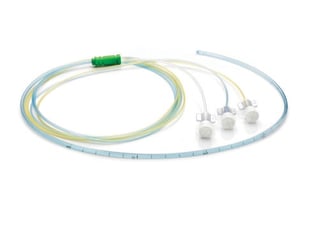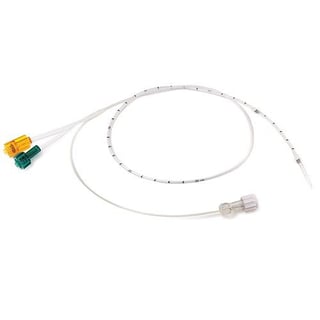Urodynamic1 testing involves a series of tests that measure the functioning of the lower urinary tract in men and women. It is the gold standard for diagnosing issues related to urine leakage, frequent urination, painful urination, difficulties starting a urine stream, inability to completely void the bladder, and recurrent urinary tract infections.
Short Medical Explanation
To perform urodynamic tests, a catheter is inserted through the urethra and into the bladder. The bladder is emptied and metrics such as urine flow rate and residual urine volume are measured. Next, the bladder is refilled in order to determine bladder pressure, bladder volume before the urge to urinate is experienced, the volume required before bladder leakage occurs, and pressure flow, among others.
These tests are routine and can be performed in approximately 30 minutes. There are two types of catheters typically involved: an air charged and a water charged urodynamic catheter. The similarities and differences of these devices will be compared here.
What is a Water Charged Urodynamic Catheter?
A water charged catheter is most commonly used for urodynamic studies. One line of the catheter is placed directly into the bladder and contains an internal or external transducer for measuring pressure. After the bladder is filled with sterile water or saline solution, vesical and abdominal pressures are measured via a catheter that is inserted into the rectum, vagina, or a stoma.

A column filled with water rises and falls in relation to pressure. Alternatively, a balloon at the end of the catheter that is filled with water may be used to record pressure measurements. A transducer (i.e. a device that converts energy into data) converts the data into a pressure measurement for interpretation.
The advantages of a water charged urodynamic catheter include a universal zeroing system that establishes a pre-test pressure measurement for a more accurate reading. Currently, the water charged catheter is recommended by researchers because this system has been widely studied and is well-understood.
However, the water charged urodynamic catheter is not a perfect system. Air bubbles in the catheter lines can cause discrepancies in the readings if proper care is not taken to ensure the lines are flushed appropriately.
Additionally, temperature fluctuations can also cause variations in measurements from patient to patient, or day by day. These designs are complex and the many variables associated with the pressure measurement can also lead to inaccurate readings.
What is an Air Charged Urodynamic Catheter4?
An air charged urodynamic catheter involves charging of a balloon that is placed around the catheter line. The theory and functioning of this technique is the same as the water charged system, but a miniature balloon communicates with a transducer in order to determine a pressure reading.

This system is advantageous because it eliminates inaccuracies due to changes in temperature or the presence of water bubbles. It is also inexpensive and the air charged catheters are single-use and disposable. Perhaps most importantly, an air charged urodynamic catheter is less sensitive to patient movement, particularly during coughing. These advantages of the air pressure catheter equate to less time, training, and clean up required per patient.
However, unlike the water-charged catheter there is no way to register the pressure reading at the start of the test. The system is described as overdamped2, with signal attenuation occurring above 3 Hz (versus signal attenuation above 19 Hz in the water-charged system). Rapidly changing pressures may result in a delayed or diminished response.
Which Urodynamic Catheter is Best?
Despite the numerous benefits of the air-charged urodynamic catheter over the water-charged urodynamic catheter, urologists are often strongly encouraged to use a water-charged system. Caution should be used when comparing the results from both catheters, as each has been shown to record different pressures3 under similar conditions. No matter which type of catheter is used, it is important to understand the different ways in which each system responds to dramatic changes in pressure2.
If you like the above you might also enjoy our post on Urodynamics Best Practices, or Urodynamics and Interstitial Cystitis.
References
- Swithinbank, L. V., & Webster, L. M. (2012). Basic understanding of urodynamics. Obstetrics, Gynaecology & Reproductive Medicine, 22(11), 315-320. doi:10.1016/j.ogrm.2012.09.005 Link
- Cooper, M., Fletter, P., Zaszczurynski, P., & Damaser, M. (2011). Comparison of air-charged and water-filled urodynamic pressure measurement catheters. Neurourology and Urodynamics, 30(3), 329-334. doi:10.1002/nau.20991 Link
- Valentini, F. A. (2013). Comment: Are the measurements of water-filled and air-charged catheters the same in urodynamics? International Urogynecology Journal, 25(1), 147-148. doi:10.1007/s00192-013-2236-2 Link
- Pollak, J. T., Davila, G. W., Neimark, M., & Connor, J. T. (2004). Air-charged and microtransducer urodynamic catheters in the evaluation of urethral function. International Urogynecology Journal and Pelvic Floor Dysfunction, 15(2), 124-128. doi:10.1007/s00192-004-1121-4 Link


